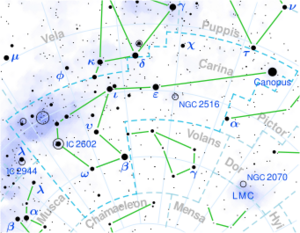Astronomy:DENIS J081730.0−615520
Coordinates: ![]() 08h 17m 30.096s, −61° 55′ 15.802″
08h 17m 30.096s, −61° 55′ 15.802″
Location of DENIS J081730.0−615520 in the constellation Carina | |
| Observation data Equinox J2000.0]] (ICRS) | |
|---|---|
| Constellation | Carina |
| Right ascension | 08h 17m 29.99888s[1] |
| Declination | −61° 55′ 15.6586″[1] |
| Characteristics | |
| Spectral type | T6[2] |
| Apparent magnitude (J) | 13.613±0.024[2] |
| J−H color index | 0.087 ± 0.039[2] |
| J−K color index | 0.093 ± 0.049[2] |
| Astrometry | |
| Proper motion (μ) | RA: −156.451(507)[1] mas/yr Dec.: 1,099.366(503)[1] mas/yr |
| Parallax (π) | 191.8362 ± 0.4186[1] mas |
| Distance | 17.00 ± 0.04 ly (5.21 ± 0.01 pc) |
| Details | |
| Radius | 0.94±0.16[3] RJup |
| Temperature | 1004±91[4] K |
| Rotation | 2.8±0.2 hours[5] |
| Age | 1[3] Gyr |
| Other designations | |
| Database references | |
| SIMBAD | data |
DENIS J081730.0−615520 (also known as 2MASS 08173001−6155158) is a T-type brown dwarf 17 light-years (5.2 parsecs) away in the constellation Carina. It was discovered by Etienne Artigau and his colleagues in April 2010.[2] The brown dwarf belongs to the T6 spectral class, with a photosphere temperature of about 1000 K.[4] It has a mass of about 15 MJ (Jupiter masses) or about 1.5% the mass of the Sun.[failed verification]
DENIS J081730.0-615520 is the fourth-nearest isolated T dwarf to the Sun (after UGPS J0722−0540, WISE 1741+2553, and WISE 1506+7027) and the eighth-nearest (also after Luhman 16B, ε Indi Bab and SCR 1845-6357B) if one takes into account T dwarfs in multiple star systems.[7] It is also the brightest T dwarf in the sky (in the J-band); it had been missed before due to its proximity to the galactic plane.[2]
References
- ↑ 1.0 1.1 1.2 1.3 Vallenari, A. et al. (2022). "Gaia Data Release 3. Summary of the content and survey properties". Astronomy & Astrophysics. doi:10.1051/0004-6361/202243940 Gaia DR3 record for this source at VizieR.
- ↑ 2.0 2.1 2.2 2.3 2.4 2.5 Artigau, Etienne et al. (2010). "DENIS J081730.0-615520: An overlooked mid-T dwarf in the solar neighborhood". The Astrophysical Journal Letters 718 (1): L38–L42. doi:10.1088/2041-8205/718/1/L38. Bibcode: 2010ApJ...718L..38A.
- ↑ 3.0 3.1 Vos, Johanna M.; Biller, Beth A.; Allers, Katelyn N.; Faherty, Jacqueline K.; Liu, Michael C.; Metchev, Stanimir; Eriksson, Simon; Manjavacas, Elena et al. (2020), "Spitzer Variability Properties of Low-gravity L Dwarfs", The Astronomical Journal 160 (1): 38, doi:10.3847/1538-3881/ab9642, Bibcode: 2020AJ....160...38V
- ↑ 4.0 4.1 Kirkpatrick, J. Davy et al. (March 2021). "The Field Substellar Mass Function Based on the Full-sky 20 pc Census of 525 L, T, and Y Dwarfs". The Astrophysical Journal Supplement Series 253 (1): 7. doi:10.3847/1538-4365/abd107. Bibcode: 2021ApJS..253....7K.
- ↑ Radigan, Jacqueline; Lafrenière, David; Jayawardhana, Ray (October 2014). "Strong Brightness Variations Signal Cloudy-to-clear Transition of Brown Dwarfs". The Astrophysical Journal 793 (2): 75. doi:10.1088/0004-637X/793/2/75. Bibcode: 2014ApJ...793...75R.
- ↑ Kirkpatrick, J. Davy; Cushing, Michael C.; Gelino, Christopher R.; Griffith, Roger L.; Skrutskie, Michael F.; Marsh, Kenneth A.; Wright, Edward L.; Mainzer, Amy K. et al. (2011). "The First Hundred Brown Dwarfs Discovered by the Wide-field Infrared Survey Explorer (WISE)". The Astrophysical Journal Supplement 197 (2): 19. doi:10.1088/0067-0049/197/2/19. Bibcode: 2011ApJS..197...19K.
- ↑ Reylé, Céline; Jardine, Kevin; Fouqué, Pascal; Caballero, Jose A.; Smart, Richard L.; Sozzetti, Alessandro (30 April 2021). "The 10 parsec sample in the Gaia era". Astronomy & Astrophysics 650: A201. doi:10.1051/0004-6361/202140985. Bibcode: 2021A&A...650A.201R. Data available at https://gruze.org/10pc/
External links
- Astronomers Announce First Clear Evidence of a Brown Dwarf – STScI news release STScI-1995-48 (November 29, 1995)
 |


